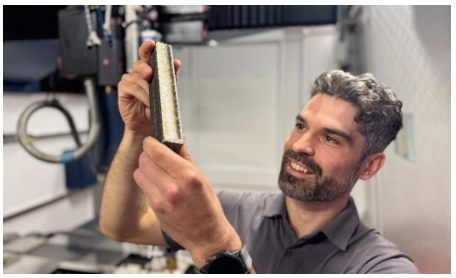Pure titanium and titanium alloys, including Ti-6Al-4V, are used in aerospace applications for forming airframes and engine parts because of their light weight, high strength, and resistance to corrosion. However, titanium is more expensive and difficult to manufacture compared to other usable materials, such as aluminum. As a result, aircraft often implement both titanium and aluminum to balance performance and costs. For example, stronger and lighter materials can provide better fuel economy.
On July 29, 2025, the Royal Melbourne Institute of Technology (“RMIT”) announced a provisional patent filing on a new titanium alloy for use with additive manufacturing. It is reported that the new titanium alloy is stronger and almost 30% cheaper than standard titanium alloys, including Ti-6Al-4V.

Ryan Brooke, PhD candidate and study lead, inspects a sample of the new titanium
Ryan Brooke, RMIT’s PhD candidate and study lead author, touted features such as “uniform grain structure,” improved ductility, and avoidance of “columnar microstructure.”
Using new alloys such as the one reported above may also improve the environment. The Air Transport Action Group (“ATAG”) published a report (Waypoint 2050) in 2021 as a roadmap to outline steps for combating climate change in part by developing improved airframes and propulsions systems, both of which can use titanium alloys, to reduce CO2 emissions. It was recently reported that ATAG is working on revising Waypoint 2050, and improving airframes and propulsion systems will likely remain as part of the roadmap.
Thus, the new titanium alloy may be a catalyst for combating climate change by making it more feasible to use a greater proportion of titanium in aircraft. The resulting aircraft could take greater advantage of titanium’s strength-to-weight ratio to reduce the size and mass of aircraft while increasing fuel economy.
A press release regarding the new titanium alloy is available here.
